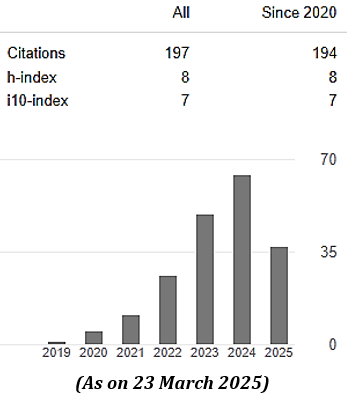EFFECT OF FIN ON THE PERFORMANCE CHARACTERISTICS OF CLOSE AND OPEN LOOP PULSATING HEAT PIPE
Abstract
Pulsating heat pipe (PHP) is a two-phase thermal control device with arbitrary number of turns which is
basically used for the thermal management of microelectronic devices as there is a requirement of
miniaturization of heat exchangers. To fulfill today's increasing demand of power electronic applications
PHP is a proven technology which works on principle of oscil lation of the working fluid and phase change
phenomenon in a capi llary tube. An experimental investigation has been done on both close and open loop
pulsating heat pipes by using suitable working fluid to observe their thermal performance. It has been
performed on 2 mm inner diameter and 2.5 mm outer diameter open and close loop pulsating heat pipe with
fin added on the condensation section. The overall experiment is done by using methanol with 50% filling
ratio at 0' (vertical) inclination angle on close loop pulsating heat pipe (CLPHP) and open loop pulsating
heat pipe (OLPHP) with 8 loops. In both the pipe evaporation section is 50mm. adiabatic section is 120 mm
and condensation section is 80 mm. The main objective of this experiment is to observe the effect of their
thermal performance while using fins and without fin i.e. the basic form. The paper attempts theoretical and
experimental investigation on the thermo-physical properties of working fluid and will also show the result
regarding the significance of using fin on CLPHP and OLPHP. Keywords: PHP, CLPHP, OLPHP, fin with
condensation section.
Downloads
References
micro-heat pipe, US Patent 5219020.
[2] H. Akachi, (1996-02-13), L-type heat pipe,
US Patent 5490558.
[3] S. Khandekar, N. Dollinger, M. Groll, (2003),
Under- standing operational regimes of pulsating
heat pipes: an experimental study, Appl. Therm.
Eng. 707-719 (ISSN 1359-4311).
[4] M. Groll, S. Khandekar, (2002), Pulsating
heat pipes: a challenge and still unsolved problem
in heat pipe science, Arch.Thermodyn. 17-28
(ISSN 1231-0956).
[5] S. Nishio, S. Nagata, S. Baba, R. Shirakashi,
(2002), Thermal performance of SEMOS heat
pipes, in: Proceedings of 12th International Heat
Transfer Conference, Grenoble, France, vol. 4, pp.
477-482 (ISBN 2-84299-307-1).
[6] M. Shafii, A. Faghri, Y. Zhang, (2001),
Thermal modeling of un looped and looped
pulsating heat pipes, ASME J. Heat Transfer 123,
1159- 1172.
[7] S. Khandekar, M. Groll, An insight into
thermo-hydrodynamic coupling in pulsating heat
pipes, Int. J. Therm . Sci.(Rev. Gn. Therm.) in press
(ISSN: 1290-0729).
MIJST follows the open access policy.

This work is licensed under a Creative Commons Attribution-NonCommercial 4.0 International License. This allows anyone to copy, share, distribute, and modify the work for non-commercial purposes, where the original work and source should be properly credited.
















